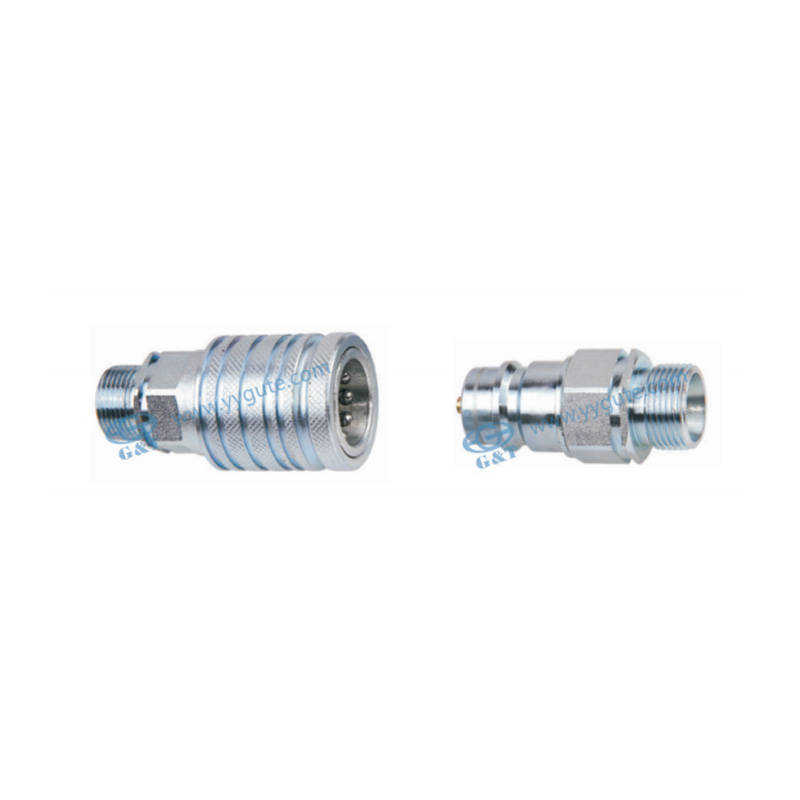Call us
+86-13732136622
+86-15058221666

Quick disconnect couplings can be used for both pneumatic and hydraulic systems, but there are some important considerations to ensure compatibility and performance:
Material Compatibility: Quick disconnect couplings are manufactured from various materials such as stainless steel, brass, aluminum, and high-performance plastics. When selecting a coupling for either pneumatic or hydraulic systems, it is crucial to ensure that the material is compatible with the specific fluid being used. For instance, certain hydraulic fluids may be corrosive to some metals, necessitating the use of corrosion-resistant materials like stainless steel. Similarly, some pneumatic systems may require lightweight materials such as aluminum to reduce the overall system weight without compromising strength and durability.
Pressure Ratings: Pneumatic systems typically operate at pressures ranging from 80 to 150 psi, whereas hydraulic systems can operate at much higher pressures, often exceeding 3000 psi. It is imperative to verify that the quick disconnect coupling can handle the maximum operating pressure of the system to prevent failures that could lead to leaks, equipment damage, or safety hazards. Manufacturers provide pressure ratings for their couplings, which must be carefully matched to the system requirements.
Seal Type: The sealing mechanism within the coupling is essential for maintaining a leak-free connection. Hydraulic systems, which use incompressible fluids, often require robust seals made from materials such as Viton, EPDM, or PTFE to withstand high pressures and resist fluid degradation. Pneumatic systems, using compressible air, may use seals such as Nitrile or silicone, which are designed to maintain a tight seal at lower pressures. Selecting the appropriate seal material ensures longevity and reliable performance in the intended application.
Connection Type: Quick disconnect couplings come in various connection types, including push-to-connect, threaded, bayonet, and cam-lock. The connection type should be chosen based on the specific requirements of the application. For example, push-to-connect couplings are commonly used in pneumatic systems for their ease of use and quick installation, while threaded couplings may be preferred in hydraulic systems for their ability to provide a secure and vibration-resistant connection. Ensuring the correct connection type helps prevent accidental disconnections and ensures operational safety.
Size and Flow Requirements: The size of the quick disconnect coupling must be matched to the flow requirements of the system. Undersized couplings can restrict flow, leading to reduced system efficiency and potential pressure drops. It is important to consider the inner diameter and flow coefficient (Cv) of the coupling to ensure it can handle the required flow rate without causing bottlenecks.
Temperature Range: Both pneumatic and hydraulic systems can operate across a wide range of temperatures. Hydraulic systems, in particular, may generate significant heat due to fluid friction and high operating pressures. Quick disconnect couplings must be capable of withstanding these temperature variations without compromising their integrity.
Safety Features: Safety is paramount in both pneumatic and hydraulic systems. Quick disconnect couplings may come equipped with safety features such as automatic shut-off valves that prevent fluid loss upon disconnection, thereby protecting personnel and equipment. Other safety features might include lockable mechanisms to prevent accidental disconnection and pressure release valves to safely vent any residual pressure before disconnection. Selecting couplings with appropriate safety features enhances the overall safety and reliability of the system.
GT-CT push-pull type hydraulic quick coupling


The GT-A1 Closed-type hydraulic quick connector is a type of hydraulic fitting designed to prevent fluid leakage from the hydraulic system. It is comm...
See Details
● Poppet valves available to prevent uncoupled leakage. ● Poppet valves open automatically when coupled, within rated working pressure, to keep the ...
See Details
The Q/ZB275 manual push and pull thread-locked hydraulic quick coupling is a type of hydraulic connector used to quickly and easily connect and discon...
See Details
The KZE-B thread sleeve locked type high pressure hydraulic quick coupling is a type of hydraulic coupling that is designed for high-pressure applica...
See Details
● Poppet valves available to prevent uncoupled leakage. ● Poppet valves open automatically when coupled, within rated working pressure, to keep the f...
See Details
Material: Carbon Steel Plating: Trivalent Chromium Temperature Range (Viton): -20℃+180℃ Working Pressure: 100mpa Thread Specification: G1/4 Applica...
See Details
Material: Carbon Steel Plating: Chrome Plated Temperature Range (Nbr): -20°C + 100°C Working Pressure: 70mpa Thread Specification: M10*1.5, M16*1.5 A...
See Details
The GT-MB low-temperature resistance brass quick coupling mould is a type of mold used in the production of brass quick couplings for low-temperature ...
See Details
The QKD156 single shut-off industrial steel air pneumatic quick coupling is a type of air fitting that is used to connect and disconnect pneumatic too...
See Details
The YJZQ-G1 carbon steel white galvanized high pressure hydraulic ball valve is a type of ball valve that is used in high-pressure hydraulic systems. ...
See Details
Contact Us